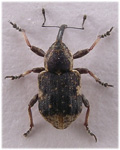Our species are included in two tribes; Erirhinini (11spp.) and Stenopelnini (1sp.). In the Erirhinini the rostrum is long, at least four times longer than wide, and parallel or subparallel. The scrobes are placed laterally and not visible from above. Tarsi with 2 claws. Pronotum without deep pores or tubercles, front margin not raised or bordered. Elytra smooth, without raised interstices or outstanding setae. Front femora not toothed. Front tibia with small tooth on inner edge apically (must sometimes be looked for very carefully), outer edge of front tibia not produced or toothed. Tarsi pseudotetramerous, third segment deeply divided and strongly lobed. Tarsi with 2 claws, free (not connate), not toothed at base or appendiculate.
The most recent work for the identification of British species is Morris.
Reference
Jansen, D.E., 1921 Ent. Mon. Mag. 57:225-226

Grypus
equiseti

Grypus
equiseti

Notaris acridulus

Notaris scirpi
Thryogenes fiorii
Home